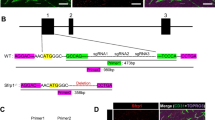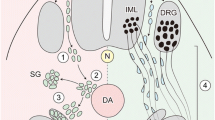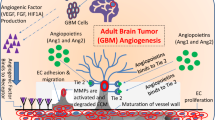Abstract
Introduction
Central nervous system hemangioblastoma is a benign tumor associated with or without von Hippel-Lindau (VHL) disease which is an autosomal dominant hereditary disease that results from a germline mutation in the VHL gene. A main axis of signaling pathways in central nervous system hemangioblastoma is VHL-HIF signaling pathway. Here, we propose an alternative VHL-JAK-STAT signaling pathway in hemangioblastoma and discuss the role.
Methods
Using MACS method, Scl+ hemangioblast-like cells were isolated from multipotent nestin-expressing stem cells. Then, ubiquitination of JAK2 in those cells and immunoprecipitation between JAK2 and VHL were examined. Then, expressions of JAK2 and STAT3 in those cells and expressions of VHL-associated hemangioblastoma tissues were examined. In addition, the VHL genes of patients bearing hemangioblastoma were analyzed.
Results
JAK2 and STAT3 in Scl+ hemangioblast-like cells were ubiquitinated after VHL- expression vector was transferred to those cells. Expressions of JAK2 and STAT3 in those cells were well recognized before the transfer, but those disappeared after the transfer. Expressions of both JAK2 and STAT3 in hemangioblastoma tissues were well shown. The VHL gene analysis revealed that patients bearing hemangioblastoma carried missense mutations in 5, small deletions in 2, large deletions in 4, and nonsense mutation in 1
Conclusions
VHL-JAK-STAT signaling pathway might play an important role in proliferation, angiogenesis, and maintenance of stem-cell-nature in hemangioblastoma as an alternative signaling pathway to supplement VHL-HIF signaling pathway.






Similar content being viewed by others
References
Kanno H, Kondo K, Ito S, Yamamoto I, Fujii S, Torigoe S, Sakai N, Hosaka M, Shuin T, Yao M (1994) Somatic mutations of the von Hippel-Lindau tumor suppressor gene in sporadic central nervous system hemangioblastomas. Cancer Res 54:4845–4847
Latif F, Tory K, Gnarra J, Yao M, Duh F, Orcutt ML, Stackhouse T, Kuzmin I, Modi W, Geil L, Schmidt L, Zhou F, Li H, Wei MH, Chen F, Glenn G, Choyke P, Walther MM, Weng Y, Duan DR, Dean M, Glavac D, Richards FM, Crossey PA, Ferguson-Smith MA, Paslier DL, Chumakov I, Cohen D, Chinault AC, Maher ER, Linehan WM, Zbar B, Lerman MI (1993) Identification of the von Hippel-Lindau disease tumor suppressor gene. Science 260:1317–1320
Stebbins CE, Kaelin WG, Pavletich NP (1999) Structure of the VHL–elongin C–elongin B complex: implications for VHL tumor suppressor function. Science 284:455–461
Maxwell P, Wiesener MS, Chang GW, Clifford SC, Vaux EC, Cockman ME, Wykoff CC, Pugh CW, Maher ER, Ratcliffe PJ (1999) The von Hippel-Lindau gene product is necessary for oxgyen-dependent proteolysis of hypoxiainducible factor-α subunits. Nature 399:271–275
Flamme I, Krieg M, Plate KH (1998) Up-regulation of vascular endothelial growth factor in stromal cells of hemangioblastomas is correlated with up-regulation of the transcription factor HRF/HIF-2alpha. Am J Pathol 153:25–29
Trimble M, Caro J, Talalla A, Brain M (1991) Secondary erythrocytosis due to a cerebellar hemangioblastoma: demonstration of erythropoietin mRNA in the tumor. Blood 78(3):599–601
Iliopoulos O, Levy AP, Jiang C, Kaelin WG Jr, Goldberg MA (1996) Negative regulation of hypoxia-inducible genes by the von Hippel-Lindau protein. Proc Natl Acad Sci USA 93:10595–10599
Gläsker S, Li J, Xia JB, Okamoto H, Zeng W, Lonser RR, Zhuang Z, Oldfield EH, Vortmeyer AO (2006) Hemangioblastomas share protein expression with embryonal hemangioblast progenitor cell. Cancer Res 66:4167–4172
Park DM, Zhuang Z, Chen L, Szerlip N, Maric I, Li J, Sohn T, Kim SH, Lubensky IA, Vortmeyer AO, Rodgers GP, Oldfield EH, Lonser RR (2007) von Hippel-Lindau disease associated hemangioblastomas are derived from embryologic multipotent cells. PLoS Med 4:e60
Takada S, Hojo M, Takebe N, Tanigaki K (2018) Miyamoto S (2018) Stromal cells of hemangioblastomas exhibit mesenchymal stem cell-derived vascular progenitor cell properties. Brain Tumor Pathol 35:193–201. https://doi.org/10.1007/s10014-018-0323-2
Kanno H, Sato H, Yokoyama TA, Yoshizumi T, Yamada S (2013) The VHL tumor suppressor protein regulates tumorigenicity of U87-derived glioma stem-like cells by inhibiting the JAK/STAT signaling pathway. Int J Oncol 42:881–886. https://doi.org/10.3892/ijo.2013.1773
Kanno H, Kubo A, Yoshizumi T, Mikami T (2013) Maegawa J (2013) Isolation of multipotent nestin-expressing stem cells derived from the epidermis of elderly humans and TAT-VHL peptide-mediated neuronal differentiation of these cells. Int J Mol Sci 14(5):9604–9617. https://doi.org/10.3390/ijms14059604
Kanno H, Xu Y, Miyakawa T, Kubo A, Higashida T, Kobayashi NB, Yoshida T, Tanokura M (2018) BC-box motif-mediated neuronal differentiation of somatic stem cells. Int J Mol Sci 19(2):E466. https://doi.org/10.3390/ijms19020466
Kanno H, Shuin T, Kondo K, Yamamoto I, Ito S, Shinonaga M, Yoshida M, Yao M (1997) Somatic mutations of the von Hippel-Lindau tumor suppressor gene and loss of heterozygosity on chromosime 3p in human glial tumors. Cancer Res 57:1035–1038
Yoshida M, Ashida K, Kondo K, Kobayashi H, Kanno H, Shinohara N, Shitara N, Kishida T, Kawakami S, Baba M, Yamamoto I, Hosaka M, Shuin T, Yao M (2000) Germ-line mutation analysis in patients with von Hippel-Lindau disease in Japan: an extented study of 77 families. Jpn J Cancer Res 91:204–212
Hattori K, Teranishi J, Stolle C, Yoshida M, Kondo K, Kishida T, Kanno H, Baba M, Kubota Y, Yao M (2006) Detection of germline deletions using real-time quantitative polymerase chain reaction in Japanese patients with von Hippel-Lindau disease. Cancer Sci 97:400–405
Ali S, Nouhi Z, Chughtai N, Ali S (2003) SHP-2 regulates SOCS-1-medated Janus kinase-2 ubiquitination /degradation downstream of the prolactin receptor. J Biol Chem 278:52021–52031
Russell RC, Sufan RI, Zhou B, Heir P, Bunda S, Sybingco SS, Greer SN, Roche O, Heathcote SA, Chow VW, Boba LM, Richmond TD, Hickey MM, Barber DL, Cheresh DA, Simon MC, Irwin MS, Kim WY, Ohh M (2011) Loss of JAK2 regulation via a heterodimeric VHL-SOCS1 E3 ubiquitin ligase underlines Chuvash polycythemia. Nat Med 17:845–853. https://doi.org/10.1038/nm.2370
Ungureanu D, Saharinen P, Junttila I, Hilton DJ, Silvennoinen O (2000) Regulation of Jak2 through the ubiquitin-proteosome pathway involves phosphorylation of Jak2 on Y1007 and interaction with SOCS-1. Mol Cell Bio 22:3316–3326
Feldman MJ, Sizdahkhani S, Edwards NA, Merrill MJ, Ray-Chaudhury A, Zhuang Z, Lonser RR, Oldfield EH, Chittiboina P (2016) Loss of quiescence in von Hippel-Lindau hemangioblastomas is associated with erythropoietin signaling. Sci Rep 6:35486. https://doi.org/10.1038/srep35486
Kaelin WG Jr (2017) The VHL tumor suppressor gene: Insights into oxygen sensing and cancer. Trans Am Clin Climatol Assoc 128:298–307
Li M, Song J, Pytel P (2014) Expression of HIF-1 regulated proteins vascular endothelial growth factor, carbonic anhydrase IX and hypoxia inducible gene 2 in hemangioblastomas. Folia Neuropathol 52:234–242. https://doi.org/10.5114/fn.2014.45564
Krieg M, Marti HH, Plate KH (1998) Coexpression of erythropoietin and vascular endothelial growth factor in nervous system tumors associated with von Hippel-Lindau tumor suppressor gene loss of function. Blood 92:3388–3393
Mukherjee T, Kim WS, Mandal L, Banerjee U (2011) Interaction between Notch and Hif-alpha in development and survival of drosophila blood cells. Science 332:1210–1213. https://doi.org/10.1126/science.1199643
Vihanto MM, Plock J, Erni D, Frey BM, Frey FJ, Huynh-Do U (2005) Hypoxia up-regulates expression of Eph receptors and ephrins in mouse skin. FASEB J 19:1689–1691
Zagzag D, Krishnamachary B, Yee H, Okuyama H, Chiriboga L, Ali MA, Melamed J, Semenza GL (2005) Stromal cell–derived factor-1A and CXCR4 expression in hemangioblastoma and clear cell-renal cell carcinoma: von Hippel-Lindau loss-of-function induces expression of a ligand and its receptor. Cancer Res 65:6178–6188
Lappin TR, Lee FS (2019) Update on mutations in the HIF: EPO pathway and their role in erythrocytosis. Blood Rev 37:100590. https://doi.org/10.1016/j.blre.2019.100590
Kaelin WG Jr (2008) The von Hippel-Lindau tumour suppressor protein: O2 sensing and cancer. Nat Rev Cancer 8:865–873. https://doi.org/10.1038/nrc2502
Pierscianek D, Wolf S, Keyvani K, El Hindy N, Stein KP, Sandalcioglu IE, Sure U, Mueller O, Zhu Y (2017) Study of angiogenic signaling pathways in hemangioblastoma. Neuropathology 37:3–11. https://doi.org/10.1111/neup.12316
Tarade D, Ohh M (2017) The HIF and other quandaries in VHL disease. Oncogene 37:139–147. https://doi.org/10.1038/onc.2017.338
Dai H, Wang C, Yu Z, He D, Yu K, Liu Y, Wang S (2018) MiR-17 regulates prostate cancer cell proliferation and apoptosis through inhibiting JAK-STAT3 signaling pathway. Cancer Biother Radiopharm 33:103–109. https://doi.org/10.1089/cbr.2017.2386
Dolatabadi S, Jonasson E, Lindén M, Fereydouni B, Bäcksten K, Nilsson M, Martner A, Forootan A, Fagman H, Landberg G, Åman P, Ståhlberg A (2019) JAK-STAT signalling controls cancer stem cell properties including chemotherapy resistance in myxoid liposarcoma. Int J Cancer 145:435–449. https://doi.org/10.1002/ijc.32123
Kowshik J, Baba AB, Giri H, Deepak Reddy G, Dixit M, Nagini S (2014) Astaxanthin inhibits JAK/STAT-3 signaling to abrogate cell proliferation, invasion and angiogenesis in a hamster model of oral cancer. PLoS ONE 9:e109114. https://doi.org/10.1371/journal.pone.0109114
Ruan Z, Yang X, Cheng W (2018) OCT4 accelerates tumorigenesis through activating JAK/STAT signaling in ovarian cancer side population cells. Cancer Manag Res 11:389–399. https://doi.org/10.2147/CMAR.S180418
Villarino AV, Kanno Y, O'Shea JJ (2017) Mechanisms and consequences of Jak-STAT signaling in the immune system. Nat Immunol 18:374–384. https://doi.org/10.1038/ni.3691
Wang S, Zhang S, He Y, Huang X, Hui Y, Tang Y (2019) HOXA11-AS regulates JAK-STAT pathway by miR-15a-3p/STAT3 axis to promote the growth and metastasis in liver cancer. J Cell Biochem 120:15941–15951. https://doi.org/10.1002/jcb.28871
Xu CH, Liu Y, Xiao LM, Chen LK, Zheng SY, Zeng EM, Li DH, Li YP (2019) Silencing microRNA-221/222 cluster suppresses glioblastoma angiogenesis by suppressor of cytokine signaling-3-dependent JAK/STAT pathway. J Cell Physiol 234:22272–22284. https://doi.org/10.1002/jcp.28794
Zhang Y, Wang D, Xu J, Wang Y, Ma F, Li Z, Liu N (2019) Stat3 activation is critical for pluripotency maintenance. J Cell Physiol 234:1044–1051. https://doi.org/10.1002/jcp.27241
Zyuz'kov GN, Udut EV, Miroshnichenko LA, Polyakova TY, Simanina EV, Stavrova LA, Prosekin GA, Zhdanov VV, Udut VV (2018) Role of JAK/STAT3 signaling in functional stimulation of mesenchymal progenitor cells with alkaloid songorine. Bull Exp Biol Med 165:665–668. https://doi.org/10.1007/s10517-018-4237-0
Thomas SJ, Snowden JA, Zeidler MP, Danson SJ (2015) The role of JAK/STAT signalling in the pathogenesis, prognosis and treatment of solid tumours. Br J Cancer 113:365–371. https://doi.org/10.1038/bjc.2015.233
Kamura T, Conrad MN, Yan Q, Conaway RC, Conaway JW (1999) The Rbx1 subunit of SCF and VHL E3 ubiquitin ligase activates Rub1 modification of cullins Cdc53 and Cul2. Genes Dev 13:2928–2933
Kamura T, Sato S, Haque D, Liu L, Kaelin WG Jr, Conaway RC, Conaway JW (1998) The Elongin BC complex interacts with the conserved SOCS-box motif present in members of the SOCS, ras, WD-40 repeat, and ankyrin repeat families. Genes Dev 12:3872–3881
Krebs DL, Hilton DJ (2001) SOCS proteins: negative regulators of cytokine signaling. Stem Cells 19:378–387
Kamizono S, Hanada T, Yasukawa H, Minoguchi S, Kato R, Minoguchi M, Hattori K, Hatakeyama S, Yada M, Morita S, Kitamura T, Kato H, Ki N, Yoshimura A (2001) The SOCS box of SOCS-1 accelerates ubiquitin-dependent proteolysis of TEL-JAK2. J Biol Chem 276:12530–12538
Author information
Authors and Affiliations
Contributions
Conception and design: HK; Acquisition of data: HK, TY, HM, MS, AK, MY; Analysis and interpretation of data: HK, TY, AK, MY; Drafting the article: HK; Reviewed submitted version of manuscript: HK; Approved the final version of the manuscript on behalf of all authors: HK; Administrative/technical/material support: HK, TY, MS, MY; Study supervision: HK, MY.
Corresponding author
Ethics declarations
Conflicts of interest
No authors have relevant conflicts of interest.
Ethical approval
Written informed patient consent was obtained for studying germline analysis and protein expression profiles, and the study protocol was approved by the institutional ethics committee.
Additional information
Publisher's Note
Springer Nature remains neutral with regard to jurisdictional claims in published maps and institutional affiliations.
Rights and permissions
About this article
Cite this article
Kanno, H., Yoshizumi, T., Shinonaga, M. et al. Role of VHL-JAK-STAT signaling pathway in central nervous system hemangioblastoma associated with von Hippel-Lindau disease. J Neurooncol 148, 29–38 (2020). https://doi.org/10.1007/s11060-020-03506-8
Received:
Accepted:
Published:
Issue Date:
DOI: https://doi.org/10.1007/s11060-020-03506-8




